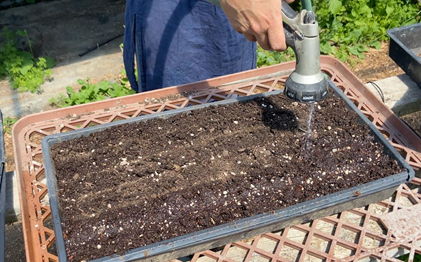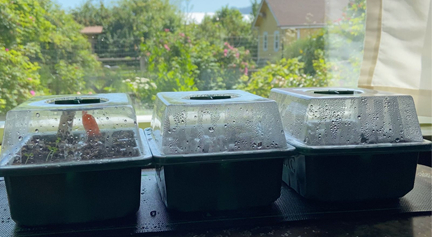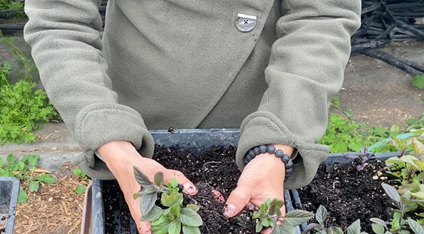
Home >> Newsletters > GreenFriends Newsletters > Q3 2024 Newsletter
| Home | Source Reduction | Friends of Green Friends | Newsletters |
| Gardening | Resources | What You Can Do | Embracing The Trees |
| Growing Tulasi | ||||
| A Path to Nurturing a Sacred Bond with Nature | ||||
 Amma hugs a Tulasi plant |
||||
|
Tulasi, also known as Holy Basil or Ocimum Sanctum, is a highly medicinal herb that has been revered since ancient times as one of the most sacred plants in Indian culture. As Amma beautifully explains: "Tulasi leaves are highly medicinal. In ancient India, it was a daily practice to water Tulasi each morning for her blessings, bowing down with reverence and devotion, and worshiping her as an embodiment of the Goddess. Reviving such practices can help us restore the lost harmony in our lives." (see pages 4 and 5 of Man and Nature). For over twenty-five years, Amma has encouraged the cultivation of Tulasi worldwide through the GreenFriends initiative, offering practical guidelines on growing the herb. Caring for Tulasi will nurture a deeper connection to Mother Nature in our hearts and can help us to awaken the experience of the Divine in all creation. Amma says, "Nature is nothing but God’s visible form, which we can see and experience through our senses. Indeed, by loving and serving Nature, we are worshiping God directly." Tulasi literally means "The Incomparable One." When you consider the herb's numerous medicinal benefits, it truly lives up to its name. The list of its healing properties and uses could fill an entire book. In Amma’s biography, we learn that during her sadhana leela, she would live for months at a time, subsisting solely on Tulasi leaves. Amma shares a beautiful story: Once, Radha was plucking Tulasi leaves to weave a garland for her beloved Lord Krishna. Suddenly, she was overcome with compassion and asked, "Oh Mother Tulasi, do you not feel pain when we pluck your leaves?" Tulasi replied, "Yes, Radha, I do feel pain. But when I see your happiness as you offer a garland of my leaves to the Lord, all my pain disappears." This story powerfully symbolizes nature's self-sacrifice, as it constantly gives of itself to sustain and support us. Growing Tulasi offers us the opportunity to return that gratitude, love and service to Mother Nature. For all she gives us, what can we offer in return? We can offer our hearts. This love and awareness will reflect in each of our actions. Through the simple act of growing Tulasi in our homes, may we receive the blessings of Mother Nature and Amma - bringing harmony, well-being, and grace into our daily lives. "We should grow plenty of trees and medicinal plants, as they cleanse the air. Many diseases can be prevented by breathing air that has come into contact with medicinal plants." - Amma |
||||
|
Growing Tulasi: Practical Tips
|
||||
 Sowing Tulasi seeds |
||||
| Top Native to India, Tulasi requires special care to thrive in non-native climates. Start seeds indoors in the spring. The seeds need high temperatures to germinate - ideally a consistent 78°F (26°C). Seedlings may emerge within 1 to 6 weeks, depending on the consistency of heat and other factors. For extra warmth, use an electrical seedling mat (easily available online,) or place the seeds above a heater. For a mini-greenhouse effect, use trays that come with a clear plastic lid, or create your own by covering the trays with clear plastic bags or a pane of glass. These methods will trap heat and humidity. Place your tray on the mat in a sunny window. Amma has given a simple suggestion for sowing the seeds: Cup the seeds in your hands and hold them in the golden rays of the setting sun for 5 minutes. Then, immediately sow the seeds. Sow them directly on the surface of fine, organic seedling soil mix or sifted potting soil mixed with one-third non-salty sand. Moisten the soil before planting. Sprinkle the seeds thinly or space them one inch apart. Using a sifter, sprinkle a very thin dusting of soil, just enough to cover the seeds. Water with a gentle spray. Keep the soil evenly moist during germination. If sown in individual cells or containers, gently separate the seedlings when they have four sets of leaves and transplant them into individual pots. Water well during transplanting and take care not to disturb the roots. As Tulasi grows, continue transplanting into gradually larger pots. Always use pots with good drainage holes and organic, well-draining potting soil mix. |
||||
 Watering Tulasi seeds |
||||
| Gently pinch off the top of the plant when it has about 6-10 sets of leaves. This will encourage branching. As the plant grows, continue to pinch the tip of each stem after 5-6 pairs of leaves have grown. Also, pluck the flower buds as soon as they appear to redirect the plant's energy toward producing new leaves. Regularly removing older leaves, tips, and flower buds will help maintain a fuller, healthier plant.
Water as needed, but avoid overwatering, as this can lead to disease. Tulasi requires plenty of oxygen in the soil for healthy roots. Check daily by pressing your finger into the surface of the soil. Allow the soil to dry between waterings, but do not let the plant remain dry for more than 1-2 days. Tulasi enjoys lukewarm water and misting with a spray bottle to increase humidity. Feed occasionally with organic fertilizer, following the product's instructions, or use well-decomposed compost or dried cow manure with a little wood ash. Tulasi needs plenty of sunlight and warmth, so it is usually best to grow the plant indoors near a sunny window. In warm climates, the pot can be kept outside in direct sunlight during the warmer months. Tulasi thrives outdoors in hot, humid climates. In winter, the plant will require special care, and you may need to use plant lights, such as full-spectrum bulbs found at gardening centers. Alternatively, you may choose to grow Tulasi as an annual plant. |
||||
|
||||
|
Consuming just 1-2 Tulasi leaves daily is sufficient to receive both the medicinal and spiritual benefits. When the plant is fully grown, you can allow a few branches to flower and produce seeds. However, avoid letting the entire plant flower at once. For more information: Tulasi Devi, Goddess of Devotion, available at https://theammashop.org/products/tulasi-devi-goddess-of-devotion?_pos=4&_sid=34ec79d32&_ss=r. Amrita Virtual Academy’s excellent Tulasi growing workshop available: https://www.amritavirtualacademy.com/courses/tulasi-workshop |
||||
 Trays with mini ‘greenhouse’ lids |
||||
|
Traditional Prayers or Mantras with Translation for Tulasi Worship
|
||||
|
Vrindayai tulasi devyai I offer my prayers to Tulasi Devi Chant while circumambulating the Tulasi plant three times: Yani kani cha papani By circumambulating Tulasi Devi Sarvaga, Amritapuri, IN |
||||
Read The Blessings of Nature in the Q3 2024 Newsletter >>
| Home | Source Reduction | Friends of Green Friends | Newsletters | Resources | What You Can Do | Embracing The Trees |
For more information, e-mail info@greenfriendsna.org |
||||||

